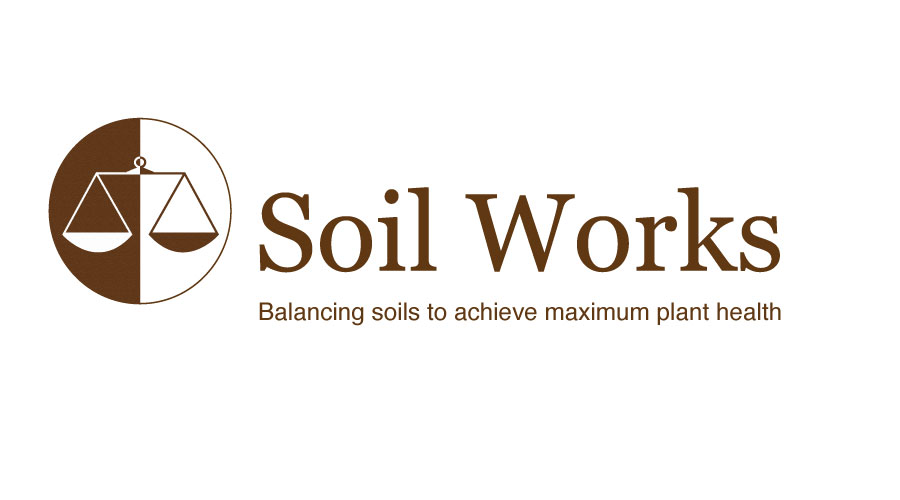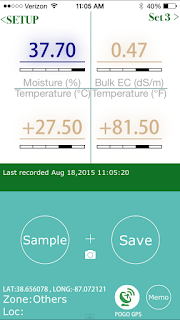Site Analysis – Basic
Information
Site visit date: 08/17/15
Greens
Profile Information:
Age: 20+
yearsOriginal Construction - sand modified with peat (90/10) – blended onsite
Original Established Cultivar Species - Penncross creeping bentgrass
Interseeded Cultivars - Crenshaw creeping bentgrass, Cato creeping bentgrass
Annual Bluegrass Contamination – 20 to 50%
Organic Matter Accumulation - distinct layer of organic matter accumulation down to 4” depth, did not appear to be anaerobic
Infiltration Characteristics - greens received .5” of natural precipitation the previous night and demonstrated reasonable uniform hydration throughout the profile
Situation:
On the weekend of August 1st, greens demonstrated visual symptoms of moderate drought stress. In response to moisture stress, irrigation event duration and frequency was immediately increased.
Within two days after initiation of increased irrigation, rapid turf decline continued to the point of selective necrosis of Poa annua. A few days after the damage had stabilized, all greens were spiked and seeded with Pencross creeping bentgrass @ 1.5 lbs./M. At the time of my visit, 14+ days had elapsed without any sign of germination in the damaged areas.
On-Site Observations:
Turf loss appeared to be limited to Poa annua, but not all Poa was equally impacted.
Based on the pattern of necrosis, there was a direct correlation between the amount of turf loss and the environmental conditions associated with individual greens. Greens with poor air movement and less than full sun exposure experienced greater turf loss. These greens also exhibited higher populations of Poa annua.
There was also greater turf loss (Poa) on green surfaces or sections of greens that had a greater amount slope.
Green 13 best matched the above mentioned criteria (i.e. poor air movement, reduced exposure to direct sunlight and high % slope).
Utilizing a POGO http://www.stevenswater.com/soil_moisture_sensors/ field diagnostic tool, we were able to verify that the highest EC readings were in fact on the higher sloped areas of green surfaces. These same areas also had lower moisture readings than surrounding areas of less slope.
Not being able to germinate bentgrass seed in 14 days under ideal conditions (temperature, moisture), also points to the suspicion of restrictive salt accumulation.
On-Site Initial
Conclusion:
Visually assessing the damaged turf along with the input from the POGO, is that there was a distinct accumulation of soluble salt in the upper portion of the soil profile. Probably from a combination of poor quality irrigation water, the inability of the profile to properly flush and accumulation of sodium due to upward capillary movement within the profile driven by increased evapotranspiration rates.
The surface levels of salt accumulation were sufficient on the higher % slope areas to selectively shut down the root function of Poa annua plants due to reduced rooting depth – especially prevalent on greens impacted by environmental challenges (reduced light and air circulation).
Poa annua on the less sloped areas and not subjected to environmental challenges, was able to survive due to increased vertical movement of water down through the profile (effectively reduced the concentration of sodium in the upper soil profile) and maintaining a marginally healthier root system.
Bentgrass survived due to its selective tolerance to salt over Poa annua along with a more functional root system penetrating further down into the soil profile. The difference between surviving and dying depended on both plant tolerance and concentration gradients in regards to salt accumulation within the soil profile. Furthermore, salt accumulation within the soil profile was a direct function of surface slope and infiltration permeability.
Field Testing
Protocol:
Representative
soil and irrigation water samples were gathered and submitted for the following
tests http://www,loganlabs.com :
Basic Soil Test – nutrient accessibility
Saturated Paste Test – nutrient availability (bicarbonate, soluble salt, sodium)
Irrigation Water Suitability Test - conductivity, SAR, alkalinity, bicarbonate
Physical Infiltration Test – Saturated Hydraulic Conductivity at 0-4” and >4”
Basic Soil Test – nutrient accessibility
Saturated Paste Test – nutrient availability (bicarbonate, soluble salt, sodium)
Irrigation Water Suitability Test - conductivity, SAR, alkalinity, bicarbonate
Physical Infiltration Test – Saturated Hydraulic Conductivity at 0-4” and >4”
The
results of these tests should provide a better understanding of the dynamics
involved in this situation and provide a strategy for remediation.
Initial Field Recommendation – Pending Test Results:
Apply KaPre Exalt (Humic Acid penetrant) www.lidochem.com/Fertilizer-Product.../KaPre @ 2.0 gl./acre + Holganix (biological inoculant) http://www.holganix.com @ 2.4 gl./acre - pulse irrigation (frequent cycles with reduced duration) to gradually move sodium from surface to deeper into soil profile while minimizing surface runoff. Use POGO to verify achieving acceptable EC values.
Topdress seeding with Healthy Grow 2-4-3 Holganix (composted nutrition providing soil stable carbon and supplemental calcium) http://www.holganix.com/products/granular @ 5 lbs./M.
Apply Command (penetrating surfactant) http://www.foliarpak.com @ 24 oz./acre + Root Guard (bio stimulants, mycorrhizae, other beneficial biology) http://www.foliarpak.com @ 2.0 gl./acre + Turbo MKS (soil available source of Mg, K, S) http://www.foliarpak.com @ 10 gl./acre – apply directly over the top of new seeding and water-in.
Continue to monitor EC levels with POCO and follow-up as needed with Cal-Pull (organic-amino acid chelated calcium) http://www.enp.com @ 5 gl./acre + Command @ 24 oz./acre + Holganix @ 2.4 gl./acre – water-in.
After germination topdress with Healthy Grow 2-4-3 Holganix @ 5.0 lbs./M
Enhance new seeding establishment with Amperage 12-0-0 (high energy food and essential nutrient supplement) http://www.foliarpak.com @ 1-2 gl./acre + Root Guard @ 1-2 gl./acre + AS Fusion 7-0-0 (liquid ammonium sulfate plus amino acid) http://www.foliarpak.com @ 2 gl./acre – apply every 7-14 days
Continue to monitor surface EC levels and continue to add supplemental potassium, magnesium and sulfur with monthly applications of MKS Turbo @ 10 gl./acre along with Holganix liquid @ 2.4 gl./acre until the cessation of photosynthetic activity (soil temperatures <40F).
Fall Aerification – incorporate Healthy Grow 2-4-3 Holganix @ 10 lbs./M and supplement with soluble gypsum @ 10 lbs./M
Soil and
Irrigation Testing Results:
Soil and saturated paste reports by themselves are not indicative of the severity of the problem that currently exists. Elevated soil pH, moderately high bicarbonates, unbalanced soluble cations (% sodium > % potassium) are definitely potential issues, but not representative of the turf loss experienced. The disconnect lies in estimating average salt concentrations over a 4-5” profile depth vs. local concentrations at 1-2” depths – inconsistencies verified by POGO.
Irrigation
water report demonstrated high alkalinity (highly buffered, elevated pH) and
excess bicarbonate. Definitely a major indicator of potential soil and plant
issues, especially during periods of frequent irrigation and elevated
evapotranspiration, but by itself would not predict the dramatic turf loss
scenario that occurred.
Poor
water quality, reduced profile infiltration rates, challenged root function,
increased surface drainage and high ET made for the perfect storm. Of all the factors influencing this unfortunate outcome, reduced
profile infiltration is the most restrictive of all. Enhanced profile infiltration
is critical in building soil buffers, protecting the plant from less than ideal inputs. In older USGA and modified sand-based greens, it is a major hindrance to implementing successful water management strategies - negatively impacting both plant and fiscal health.
It will
be interesting to get the physical test results for current organic layer
(upper profile) hydraulic conductivity and see how they differ from original
construction values (lower profile).
Green 13 - moderately sloped, reduced air movement, >90% Poa loss
Green 13 - profile, 4" organic layer, no algae indicates turf expired quickly (14 days ago)
Green 13 - bentgrass is virtually unaffected since rooting extends below high salt accumulation zone
Green 16 - very little slope, < 5% Poa loss within last 14 days
Green 16 - profile, 4" organic layer
Green 16 - unaffected Poa due to reduced sodium accumulation in upper profile, the presence of algae is indicative of previous turf damage
Green PP - moderate slope, 30% Poa loss (only in higher % sloped areas)
Green PP - POGO reading on high slope bentgrass area
POGO - Moisture / EC (very high salt)
Reduced slope areas had dramatically lower EC's (< .30)
Application Update:
08/26/15
Initial application of Exalt @ 2 gl./acre + Holganix @ 2.4 gl./acre was made and watered-in.
EC's dropped from .65 to .35
Initial application of Exalt @ 2 gl./acre + Holganix @ 2.4 gl./acre was made and watered-in.
EC's dropped from .65 to .35
Recommendation made by Kevin Wolfe to spike and inter-seed greens.
09/01/15
Apply ENP Cal-Pull @ 5 gl./acre + Aquaduct @ 16 oz./acre - treat seeded areas and water-in.
09/04/15
Seed is germinating, but EC readings are going back up. Recommendation is for repeat application of Exhalt + Holganix + Aquaduct
Seed is germinating, but EC readings are going back up. Recommendation is for repeat application of Exhalt + Holganix + Aquaduct










No comments:
Post a Comment